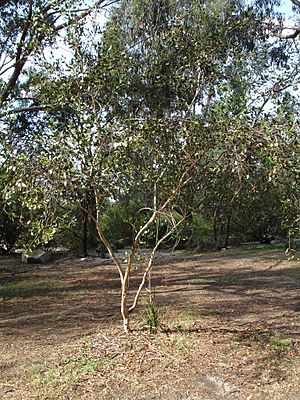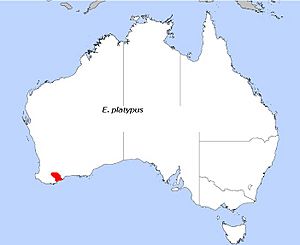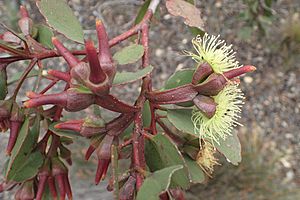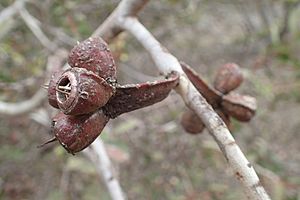Moort facts for kids
Quick facts for kids Moort |
|
|---|---|
 |
|
| Young Eucalyptus platypus in Maranoa Gardens | |
| Scientific classification | |
| Genus: |
Eucalyptus
|
| Species: |
platypus
|
 |
|
| E. platypus, where it grows | |
Eucalyptus platypus, often called moort or maalok, is a special type of mallee or marlock plant. This means it's a small tree or shrub with many stems growing from the ground. It is only found naturally in the southwest part of Western Australia.
This plant has smooth bark and leaves that are broadly oval or round. Its flower buds grow in groups of nine on a wide, flat stem. The flowers are usually creamy white, and the fruit is shaped like a cone and points downwards.
Contents
What Moort Looks Like
Eucalyptus platypus is a mallee or marlock, which means it's a type of eucalyptus that grows as a small tree or shrub. It usually reaches a height of 1.5 to 10 meters (about 5 to 33 feet) and can spread out 5 to 10 meters wide. It has a thick, rounded top.
Its bark is smooth and can be brownish or copper-colored. Young plants have egg-shaped or round leaves, about 40-65 mm (1.5-2.5 inches) long and wide. Adult leaves are shiny green on both sides, broadly oval to round, and measure 30-50 mm (1.2-2 inches) long and 20-40 mm (0.8-1.6 inches) wide. These leaves grow on a thick stem called a petiole.
The flower buds grow in groups where the leaves meet the stem. They are on a wide, flat stem that is 13-40 mm (0.5-1.6 inches) long and 10-20 mm (0.4-0.8 inches) wide. The buds themselves are long, about 25-32 mm (1-1.3 inches) long and 7-9 mm (0.3-0.35 inches) wide. They have a horn-shaped cap.
Moort flowers from September to December, or sometimes from January to March. The flowers are usually creamy white, but can also be yellowish-green or even pinkish. After flowering, the plant produces woody, cone-shaped fruits that point downwards. These fruits are about 10-17 mm (0.4-0.7 inches) long and 10-12 mm (0.4-0.5 inches) wide.
Naming and History
The scientific name Eucalyptus platypus was first officially described in 1851 by a botanist named William Jackson Hooker. He wrote about it in his book Icones Plantarum. The plant material he studied was collected near King George's Sound by James Drummond.
The second part of its scientific name, platypus, comes from ancient Greek words. "Platys" means "broad" or "flat," and "pous" means "foot." This name refers to the broad, flat stem (peduncle) where the flower buds grow.
In 2002, two scientists, Ian Brooker and Stephen Hopper, described two different types (subspecies) of Eucalyptus platypus:
- Eucalyptus platypus subsp. congregata: This type has leaves that are always oval and longer flower stems.
- Eucalyptus platypus subsp. platypus: This is the original type.
The Noongar Aboriginal people, who are the traditional owners of the land where this plant grows, call this species maalok or moort.
Where Moort Grows
Moort is found in an area of Western Australia between the towns of Albany and Esperance. It grows on flat lands and in hilly, rocky areas. You can find it in sandy, loamy, or clay soils, often near a type of soil called laterite. It grows from coastal areas as far west as Broomehill and east to Ravensthorpe.
Sometimes, this plant can spread very easily in areas where the natural environment has been disturbed, like on the Eyre Peninsula. When it grows very densely, its thick, low-growing leaves can stop other smaller native plants from growing underneath.
How Moort is Used
Moort is a fast-growing plant that is often sold in nurseries for gardening. It is a good choice for heavy soils. It can handle both frost and dry conditions, and it can even tolerate waterlogging (when the soil is too wet) and smog.
This plant responds well to pruning (trimming) and is good for coppicing, which is a way of cutting it back to encourage new growth from the base. Because it grows in a bushy way, it's very useful as a windbreak to protect other plants or areas from strong winds. Also, because it produces many flowers, it's great for beekeepers and helps with honey production.
Conservation Status
The Western Australian Government's Department of Parks and Wildlife has classified this eucalyptus as "not threatened." This means it is not currently at risk of disappearing.



